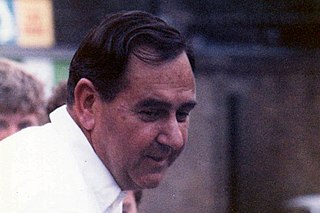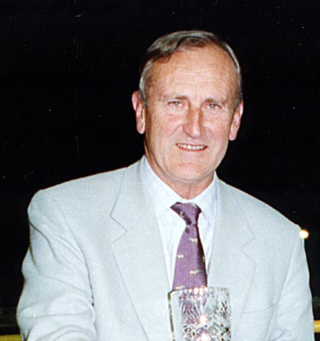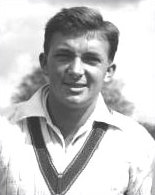
Michael Colin Cowdrey, Baron Cowdrey of Tonbridge, was an English cricketer who played for Kent County Cricket Club from 1950 to 1976, and in 114 Test matches for England from 1954 to 1975. He was born in Ootacamund, Madras Presidency, British India and died in Littlehampton, West Sussex.

James Charles Laker was an English professional cricketer who played for Surrey County Cricket Club from 1946 to 1959 and represented England in 46 Test matches. He was born in Shipley, West Riding of Yorkshire, and died in Wimbledon, London.
Michael John Knight Smith, better known as M. J. K. Smith or Mike Smith, is an English former cricketer who was captain of Oxford University Cricket Club (1956), Warwickshire County Cricket Club (1957–1967) and the England cricket team (1963–1966). He was one of England's most popular cricket captains and, as he also played rugby union, Smith was England's last double international.

Edward Ralph Dexter, was an England international cricketer.

Frederick Sewards Trueman, was an English cricketer who played for Yorkshire County Cricket Club and the England cricket team. He had professional status and later became an author and broadcaster.
John Brian Statham, was an English professional cricketer from Gorton, in Manchester, who played for Lancashire County Cricket Club from 1950 to 1968 and for England from 1951 to 1965. As an England player, he took part in nine overseas tours from 1950–51 to 1962–63. He was a right arm fast bowler and was noted for the consistent accuracy of his length and direction.

The Prime Minister's XI or PM's XI is an invitational cricket team picked by the Prime Minister of Australia for an annual match held at the Manuka Oval in Canberra against an overseas touring team. The Australian team usually consists of up-and-coming grade cricketers from the Canberra region and state players.
Peter May captained the English cricket team in Australia in 1958–59, playing as England in the 1958–59 Ashes series against the Australians and as the MCC in their other matches on the tour. It was widely regarded as one of the strongest teams to depart English shores, comparable with the great teams of Johnny Douglas in 1911-12 and Percy Chapman in 1928-29. It had no obvious weaknesses, and yet it was beaten – and beaten badly. By the First Test the top batsmen had made runs, the Surrey trio of Loader, Laker and Lock had taken wickets, as had Lancashire's Brian Statham. South Australia, Victoria and an Australian XI had all been beaten – the last by the crushing margin of 345 runs – and all seemed rosy for Peter May's touring team. But in the Brisbane Test they lost by 8 wickets and the rest of the series failed to offer any hope of reversing their fortunes. The reasons for their failure were manifold; the captain was too defensive; injuries affected their best players; others were too young and inexperienced such as Arthur Milton, Raman Subba Row, Ted Dexter, Roy Swetman and John Mortimore, or at the end of their career; Godfrey Evans, Trevor Bailey, Jim Laker, Willie Watson and Frank Tyson. Their morale was further bruised when faced with bowlers of dubious legality and unsympathetic umpires. Peter May was criticised for seeing his fiancée Virginia Gilligan, who was travelling with her uncle the Test Match commentator Arthur Gilligan. The press blamed the poor performance on the team's heavy drinking, bad behaviour and lack of pride – a foretaste the treatment losing teams would receive in the 1980s. It was not a happy tour by any means and it would take 12 years to recover The Ashes. As E.W. Swanton noted
It was a tour which saw all sorts of perverse happenings – from an injury list that never stopped, to the dis-satisfaction with umpiring and bowlers' actions that so undermined morale. From various causes England gave below their best...
The 1961 Australian cricket tour of England began with a three-day match versus Worcestershire at the County Ground, New Road, Worcester on Saturday 29 April, play continuing on Monday 1 May and Tuesday 2 May. This match was rain-affected and ended in a draw. The tour ended at Trinity College Park, Dublin on 19 September when the Australians completed a 282 run victory in a two-day match versus Ireland.
M.J.K. Smith captained the English cricket team in Australia in 1965–66, playing as England in the 1965-66 Ashes series against the Australians and as the MCC in their other matches on the tour. The 5-Tests series ended in 1–1 draw. Although they failed to reclaim the Ashes this was not unexpected as the Australian press labelled them the weakest MCC team to arrive in Australia and the bookmakers were giving odds of 7/2 on their winning the series. These views rapidly changed as they set about winning their state matches with exciting, aggressive cricket and by the First Test the odds against them had been reduced to evens. Lindsay Hassett said "other teams from England may have been better technically but none had tried so hard to make the game as interesting as possible". Financially the tour's receipts were much lower than in 1962–63 due to the number of rain-affected games in a wet Australian summer and the general doldrums of the sixties.
1961 was the 62nd season of County Championship cricket in England. Australia retained the Ashes by winning the Test series 2–1. Hampshire won their first championship title.
1962 was the 63rd season of County Championship cricket in England.
Playfair Cricket Annual is a compact annual about cricket that is published in the United Kingdom each April, just before the English cricket season is due to begin. It has been published every year since 1948. Its main purposes are to review the previous English season and to provide detailed career records and potted biographies of current players. It is produced in a "pocket-sized" format, being approximately 5×4 in, so that it is a convenient size for carrying to cricket matches. The front cover of each edition has featured a photograph of a prominent current cricketer. There is a popular myth that this "honour" has a "hex" or "curse" associated with it, as the player featured then invariably has a poor season.
The Indian cricket team toured England in the 1959 season. The team played five Test matches against England and lost them all: the first time that England had won all the matches in a five-match series. Only one of the Tests, the game at Manchester, went into the fifth day.
The Pakistan cricket team toured England in the 1962 season to play a five-match Test series against England. They also played a match in Ireland. The team is officially termed the Second Pakistanis as it was their second tour of England, following their inaugural tour in 1954. The Test series was the third between the two teams after those in England in 1954 and in Pakistan in 1961–62. Ted Dexter captained England in four Tests and Colin Cowdrey in one; Javed Burki captained Pakistan in all five Tests. England won the series 4–0 with one match drawn.
The English cricket team in the West Indies in 1959–60 played five Test matches, eight other first-class matches and two minor games. England won the Test series by one match to nil, with the other four matches being drawn.

The 1958–59 Ashes series consisted of five cricket Test matches, each scheduled for six days with eight ball overs. It formed part of the MCC tour of Australia in 1958–59, and the matches outside the Tests were played in the name of the Marylebone Cricket Club. The England team led by Peter May was labelled the strongest ever to leave England. It had the formidable bowling attack of Fred Trueman, Frank Tyson, Brian Statham, Peter Loader, Jim Laker and Tony Lock; the all-rounder Trevor Bailey; the outstanding wicket-keeper Godfrey Evans; and the batting of Colin Cowdrey, Tom Graveney, Raman Subba Row and Ted Dexter. They had won the last three Ashes series in 1953, 1954–55 and 1956, but lost the series 4–0 to Australia. It was one of the biggest upsets in Test cricket history and the biggest margin of defeat in an Ashes series since the 5–0 "whitewashing" inflicted by Warwick Armstrong's Australians in 1920–21.

The 1954–55 Ashes series consisted of five cricket Test matches, each of six days with five hours play each day and eight ball overs. It formed part of the MCC tour of Australia in 1954–55 and the matches outside the Tests were played in the name of the Marylebone Cricket Club. The England team was captained by Len Hutton, the first professional cricketer to lead an MCC tour of Australia. The Australian team under Ian Johnson was confident of victory, but despite losing the First Test by an innings England won the series 3–1 and retained the Ashes. They were the only touring team to win a series in Australia between 1932–33 and 1970–71 and only the second of three touring teams to win a series in Australia from behind. The tour is best remembered for the bowling of Frank "Typhoon" Tyson, who was at the time regarded as the fastest, most frightening bowler ever seen in Australia. The series saw a phenomenal concentration of bowling prowess on both sides – four of the bowlers had career Test averages under 21, another five under 25 and the remaining four under 30. Unsurprisingly therefore, the ball dominated the bat for most of the series and each side only topped 300 in an innings twice. Unlike the following series in 1958–59 there were rarely any umpiring disputes and Keith Miller wrote "Mel McInnes, Colin Hoy and Ron Wright were our leading umpires in the 1954–55 M.C.C. tour of Australia, and I have no hesitation in saying that McInnes gave the finest exhibition of umpiring in a Test series that I have experienced".
The 1958-59 Australians defeated the touring England team 4-0 in the 1958–59 Ashes series. They were seen by the English press as having little chance of winning the series against the powerful England touring team. They had only one recognised great player, Neil Harvey and had lost the fast bowling combination of Ray Lindwall and Keith Miller and the other veterans of Don Bradman's Invincible 1948 team. There were, however, signs of recovery to those who would see them and E.W. Swanton believed that on their home ground Australia would be a shade better than England. The best indication of the forthcoming series was the M.C.C. and Australian tours of South Africa in 1956-57 and 1957-58. South Africa had a strong team in the 1950s, stunning the cricketing world by drawing 2-2 in Australia in 1953-54, losing 3-2 in the closely fought 1955 series in England and fighting back from a 2-0 deficit to draw 2-2 with Peter May's England in 1956-57. In 1957-58 Ian Craig led a team labelled as the weakest to leave Australia to a 3-0 victory over the Springboks with Richie Benaud, Alan Davidson, Wally Grout, Ken Mackay, Colin McDonald, Jim Burke and Lindsay Kline all in fine form. Norm O'Neill was not taken on tour, but struck innings of 175 in three hours and 233 in four hours in successive games against Victoria and was regarded as the "New Bradman".
The Marylebone Cricket Club tour of Australia in 1958-59 under the captaincy of Peter May was its twelfth since it took official control of overseas tours in 1903-1904. The touring team played as England in the 1958–59 Ashes series against Australia, but as the MCC in all other games. In all there were 20 matches; 5 Test matches, 12 other First Class matches and 3 minor matches. It was billed as the strongest MCC team ever to tour Australia and dominated the early matches, and its heavy defeat in the Test series was seen as one of the great upsets in cricket.









